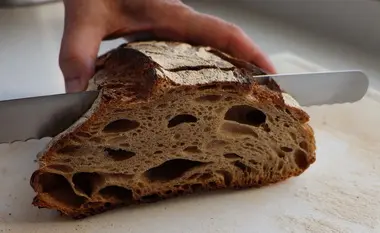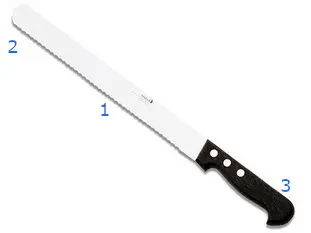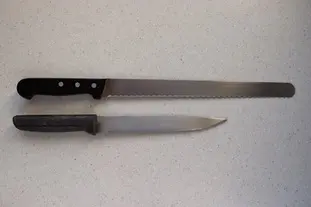The right bread knife

We almost all have a bread knife in our kitchen, that is to say the knife we use almost exclusively to cut bread.
Is this knife efficient, is it really the one you need? Here is some information to guide you in your choice.
Is this knife efficient, is it really the one you need? Here is some information to guide you in your choice.
10 K
Keywords for this post:KnifeBreadSizeBladeCuttingSawLast modified on: September 15th 2022
The right bread knife

You really need a specific knife for that, and which has, if possible, the following characteristics.

1) A serrated blade
That is to say with teeth, we often say "saw knife", as opposed to a smooth blade, which allows an easier cutting of the bread.
You will sometimes read, here or there, that you should not "tear the bread crumb" with a serrated blade, but this is nonsense.
2) A long blade
This is the main defect of bad bread knives, their blade, although serrated, is not long enough to allow a good cutting. With a long blade, your gesture will be more ample, therefore easier, and the cut more regular.
3) A wide handle
It is absolutely necessary that you have a good grip on your knife, so that its handle is comfortable and well adapted to the size of your hand.
4) Practical materials
It is not an obligation, but your bread knife must be easy to use and maintain, which in my opinion implies both a stainless steel blade and an abs plastic handle or equivalent that does not fear water.
With all these criteria, it is quite simple to find the ideal knife, the choice is quite vast fortunately.
To make a long story short, the main defect you will encounter is a blade that is too short. I advise you to opt for a blade of 10 inches (25 cm) minimum.
You will easily find a lot of bread knives with a 8 inches (20 cm) blade, which certainly cut, but are much less efficient than a 25 cm blade.

The trick I suggest is to look for, or go to a professional store, and choose what they call a "sponge knife", which is a saw knife with all the criteria we just mentioned and a 11 inches (28 cm) blade.
You will be delighted with its efficiency, to easily cut from the smallest to the largest loaf, and to make even slices.
The next time you go to your bakery, look at the knife that the sales team uses to cut the bread for the customers, it is exactly this model.
To sum up: For your bread knife, you need a stainless, long (10 inches (25 cm) minimum) and serrated blade.
Lasts posts
The grease spray
As soon as you have something in a recipe that sticks to the mold, the question always arises as to how difficult it is to remove from the mold. There's nothing more frustrating than breaking your cake when unmolding it, because part of it has stuck in the mold. The classic way to avoid this is...August 26th 20253,7175
Cake moulds
When we make a cake, or a cake of the same rectangular shape, we usually take out our usual mould and tell ourselves that the recipe is anyway "for a cake", but is it really that simple?August 25th 20254,4175
Thinning out herbs
If you need to add a long-stemmed herb (tarragon, mint, verbena, thyme, etc.) to a recipe, you'll probably only need the leaves and not the stem, so you'll need to remove the leaves. Leaf removal means keeping only the beautiful leaves, and eliminating the ugly stems and leaves, but how do you do...August 8th 20252,6335
Add a bay leaf
Bay leaf: small in size, but big in flavor. You'll find it in hundreds of recipes, and it's often added to cooking meat, in a sauce or broth, usually accompanied by other herbs or products. It's a staple of Provençal, Mediterranean and Oriental cuisine, but not the only one. Usually, in a...July 31th 20252,7375
Parsley stems
Parsley, whether curly or flat, is a delicious ingredient in many recipes, where it is used both raw and cooked. When used raw, in a salad for example, where it always provides, alone or with other herbs, a remarkable freshness, only the leaves are kept. And when used cooked?July 28th 20252,952 13
Other pages you may also like
The grease spray
As soon as you have something in a recipe that sticks to the mold, the question always arises as to how difficult it is to remove from the mold. There's nothing more frustrating than breaking your cake when unmolding it, because part of it has stuck in the mold. The classic way to avoid this is...August 26th 20253,7175
A few tips for effective kneading at home
When you have to knead dough for bread or some other recipe, you may well use a food processor or the type of machine known as a stand mixer. The best-known brands are Kenwood and KitchenAid. They are useful tools, but here are a few tips to help you get the best out of them.June 23th 2021280 K 23.7
The "caves" in the bakery and pastry shop
Maybe you've already done this? You want to make a brioche or a cake with fruit inside, you decide to proceed with your usual recipe, but also to add in the dough pieces of fresh and raw fruit, or whole fruit, for example pieces of apples or pears, good idea. When you bake it, everything seems to...March 27th 202110 K4.9
For well opened (puffed) cakes
It's always nice to have a well puffed up cake after baking, not only will it taste good but it looks great too. Let's see how to get this beautiful shape almost every time.January 23th 201932 K4.2
Vitamin C against blackening
You've probably heard of this tip: to prevent fruit or vegetables from turning brown or black, simply add or sprinkle lemon juice over them. It's very effective, but why does lemon juice have this effect?July 14th 20238,440 15
Post a comment or question
Follow this page
If you are interested in this page, you can "follow" it, by entering your email address here. You will then receive a notification immediately each time the page is modified or a new comment is added. Please note that you will need to confirm this following.
Note: We'll never share your e-mail address with anyone else.
Alternatively: you can subscribe to the mailing list of cooling-ez.com , you will receive a e-mail for each new recipe published on the site.








